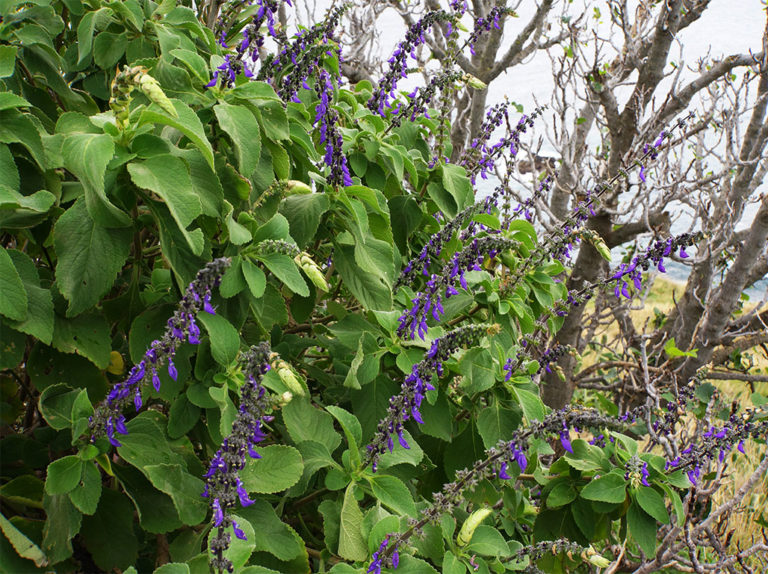Salvia Divinorum is an herb and hallucinogen like LSD
Salvia Divinorum is a species of sage (the genus Salvia) which causes hallucinations when taken and is native to Mexico. Salvia is a member of a large family of plants including mint and various herbs. When ingested, salvia produces visual hallucinogenic effects similar to LSD. Some users claim to have mystical and spiritual experiences after taking it. There are concerns that salvia potentially affects a person’s thinking, choices, and mental health.
Salvia divinorum facts
Salvia is a popular recreational drug among adolescents and young adults, who have uploaded their experiences using Salvia to YouTube and various other media platforms. We’re not including them here. The wide-ranging reactions include spacing out, giggling immensely, being incapacitated, stumbling around, or a mix of everything mentioned.
Salavia has been used for centuries
Salvia has been used for spiritual divination, shamanism, and medical practices by Mazatec Indians for centuries. The plant is associated with the Virgin Mary and is believed to give users the power to communicate with her when consumed.
Salvia risk for addiction
Salvia has a low-addiction risk, is not considered toxic, and is relatively easy to obtain. Although it may involve some danger, the long-term effects are uncertain. The hallucinations and sensations are like a dream. A person may be unable to distinguish what is real and what is not.
Salvia is a unique hallucinogen because trips are different for every user. There is no exact way to describe experiences across the board. One common thread it that it changes the body’s sense of internal conditions. It also always alters reality.
“Some people literally forgot which way was up, or didn’t know if they owned their bodies anymore. Others felt their internal organs being pulled in directions across all three planes, and through extra dimensions they hadn’t known existed. And a few could “feel” objects by looking at them.”
Newsweek
Salvia has not been deemed illegal; however, various states have declared their own legislation
Salvia Divinorum Plant
Salvia Divinorum is a hallucinogenic plant native to the northeastern Sierra Mazateca mountain region of Mexico where the native Mazatecs have used it for centuries as a healing and divining tool. Though this is the only known location where this perennial herb grows naturally, Salvia is cultivated in some areas of the United States. Salvia divinorum is not likely to be found at a local nursery although it is one among many of the cooking and medicinal herbs in the mint family.
Salvia psychological and physical effects
Resent research suggests that Salvia divinorum acts at the kappa opiate receptor (KOR) site of the brain where much of human perception is regulated. Although the Mazatec Indians have been using this herb for centuries with no obvious ill effects, it is still unclear whether Salvia divinorum causes long-term effects on the brain or on the rest of the body. There have been no reports of health problems or hospitalizations as a result of Salvia use, few dangers related to its use have been identified, and no evidence exists that it is addictive.
Although the dosage ingested and the method of ingestion affects the user’s experience, some common effects include:
- Intense hallucinations, such as sensations of traveling through time and space, of floating or flying; sensations of twisting and spinning, heaviness or lightness of the body, and “soreness.”
- Less intense effects (that occur only when the eyes are closed) include visual hallucinations of various patterns and shapes. The hallucinogenic visions produced by this herb terminate when interrupted by noise or light.
Salvia methods of use
Only when enough of Salvia’s highly active compound, Salvinorin A, is absorbed through the oral mucosa and into the blood stream can a psychoactive effect be produced. There are several methods of ingesting Salvia with varying durations of hallucinogenic effects.
- Dried leaves of Saliva can be smoked like marijuana, in a bong, pipe, or as a joint, with effects lasting up to 15 minutes. Fresh leaves of Salvia can be chewed and swallowed or chewed as a quid.
- When chewed as a quid, the leaves of Salvia produce extractions of Salvinorin A before the leaves are removed from the mouth. The extractions are absorbed through the oral mucosa and produce visual hallucinations, lasting 1 to 2 hours; the longer the herb remains in the mouth, the stronger the effect will be.
- Salvinorin A extracts can be mixed in a drink or vaporized and inhaled
- When Salvia’s leaves are crushed and the extracted Salvinorin A can be mixed with water to make a drink. Since Salvinorin A is deactivated by the gastrointestinal system before entering the blood stream this method may produce a more moderate effect than other methods.
- Salvinorin A can also be vaporized and inhaled-Salvinorin A is heated on a piece of tin foil and the vapors are inhaled through a glass pipe.
Salvia terminology
Many of the names used for Salvia divinorum indicate how the Mazatecs honor this herb for its healing and divination qualities; they believe it is the incarnation of the Virgin Mary. It has also been reported that visions of a woman are common during hallucinations. The genus name, Saliva, comes from the Latin word, salvare-meaning “to save,” while the specific name, divinorum, means “of the seers.”
Save





















